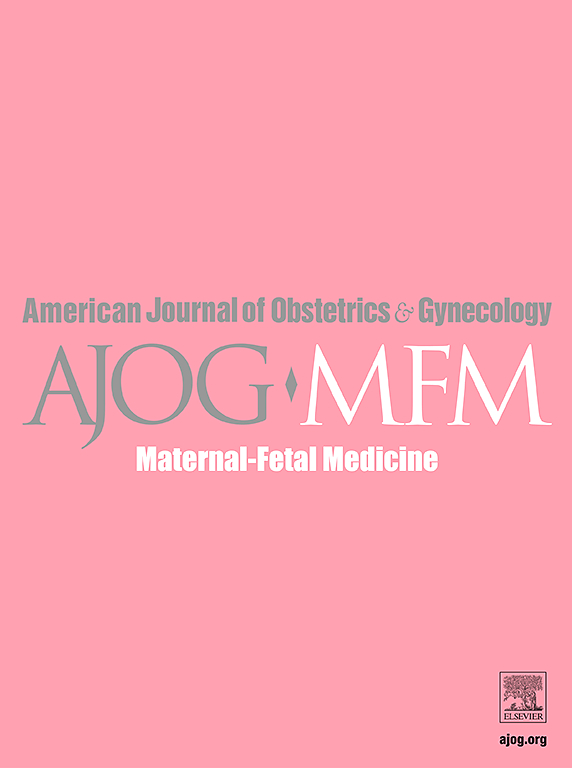常染色体三体胎盘嵌合:528例丹麦病例的全面随访(1983-2021年):常染色体三体胎盘嵌合。
IF 3.8
2区 医学
Q1 OBSTETRICS & GYNECOLOGY
American Journal of Obstetrics & Gynecology Mfm
Pub Date : 2024-09-19
DOI:10.1016/j.ajogmf.2024.101497
引用次数: 0
摘要
背景:在 2-4%的绒毛样本中可检测到嵌合现象,其特征是存在两个或两个以上染色体不同的细胞系。在这些病例中,畸变可能局限于胎盘,也可能同时出现在胎儿体内。胎儿受累可能表现为胎儿畸形,而局限性胎盘嵌合则会带来早产和出生体重低等风险。在绒毛取样时区分真正的胎儿嵌合和局限性胎盘嵌合具有挑战性,需要通过羊水穿刺和超声检查进行随访:目的:在绒毛取样中检测到常染色体三体嵌合后,估计胎儿受累或不良妊娠结局的风险,并识别高风险(红色)、中风险(黄色)和低风险(绿色)染色体。此外,还将探讨嵌合程度与筛查参数之间可能存在的关联:研究设计:对丹麦细胞遗传学中央登记处和丹麦胎儿医学数据库中1983-2021年所有绒毛样本中检测到嵌合的单胎妊娠进行回顾性描述性研究:结果:在 90,973 份绒毛样本中,有 528 个病例的嵌合体涉及常染色体三体综合征,并进行了遗传学随访。胎儿受累的总体风险为 13%(69/528),因涉及的染色体不同而有很大差异(如 7 三体:0%(0/55)或 21 三体:46%(19/41))。绒毛样本中较高的嵌合水平提示胎儿受累,因为真正胎儿嵌合的平均嵌合水平为 55%,而局限于胎盘的病例为 28%(P=0.0002)。在局限于胎盘嵌合的病例(459/528)中,分娩小于妊娠年龄新生儿的风险为14%(48/341)。早产(37 周前)风险为 15%(51/343)。在有出生体重和胎龄信息的持续妊娠中,不良结局的总体风险为 22%(76/343)。不同染色体之间的不良结果差异很大。此外,妊娠相关血浆蛋白 A 的中位数倍数(MoM)值也能预测这些问题,因为与结果正常的病例相比,结果不良的病例中的中位数倍数明显较低(胎龄小:0.23 MoM vs 0.47 MoM,p<0.05)。本文章由计算机程序翻译,如有差异,请以英文原文为准。
Placental mosaicism for autosomal trisomies: comprehensive follow-up of 528 Danish cases (1983–2021)
Background
Mosaicism, characterized by the presence of two or more chromosomally distinct cell lines, is detected in 2% to 4% of chorionic villus samples (CVSs). In these cases, the aberration may be confined to the placenta or additionally present in the fetus. Fetal involvement may manifest as fetal malformations, while confined placental mosaicism (CPM) poses risks such as preterm birth and low birth weight. Differentiating between true fetal mosaicism and CPM at the time of the chorionic villus sampling is challenging and requires follow-up by an amniocentesis and ultrasonography.
Objective
To estimate the risk of fetal involvement or adverse pregnancy outcomes for specific chromosomes after detecting mosaicism for an autosomal trisomy in a CVS and identify high (red), intermediate (yellow), and low (green) risk chromosomes. Further, to explore possible associations with level of mosaicism and screening parameters.
Study Design
A retrospective descriptive study of all singleton pregnancies with mosaicism detected in CVSs from 1983 to 2021 identified in the Danish Cytogenetic Central Registry and the Danish Fetal Medicine Database.
Results
Of 90,973 CVSs, 528 cases had mosaicism involving an autosomal trisomy and where genetic follow-up had been performed. The overall risk of fetal involvement was 13% (69/528) with extensive variations depending on which chromosome was involved (eg, trisomy 7: 0% [0/55] or trisomy 21: 46% [19/41]). Higher levels of mosaicism in the CVS suggested fetal involvement as mean mosaic level was 55% in true fetal mosaics vs 28% in cases confined to the placenta (P=.0002). In cases with CPM (459/528), the risk of delivering small-for-gestational-age neonates was 14% (48/341). The risk of preterm birth (before 37 weeks) was 15% (51/343). The collective risk of adverse outcome was 22% (76/343) in pregnancies that continued and where information on birth weight and gestational age at birth was available. Adverse outcomes varied substantially between chromosomes. Also, multiple-of-the-median (MoM) values of pregnancy-associated plasma protein A was predictive of these issues as it was significantly lower in cases with adverse outcome compared to cases with a normal outcome (small for gestational age: 0.23 MoM vs 0.47 MoM, P<.0001) or preterm birth: 0.25 MoM vs 0.47 MoM, P<.0001). After the introduction of combined first-trimester screening (cFTS) in 2004, the detection of cases with fetal involvement seemed to increase as the risk before 2004 was 9% (16/174) compared to 15% (53/354) after 2004 (risk ratio: 1.7 [95% CI: 1.0; 2.8]). The risk of adverse outcome in CPM pregnancies increased from 16% (22/139) before 2004 to 27% (55/204) after 2004 (risk ratio 1.7 [95% CI: 1.1; 2.7]).
Conclusion
Introducing cFTS increased the detection of placental mosaicism with fetal involvement and CPM with adverse outcome. In cases of mosaicism in CVSs, the risk of fetal involvement and adverse outcomes varied considerably between chromosomes. Importantly, adverse outcomes were seen in CPM for many trisomies besides trisomy 16.
求助全文
通过发布文献求助,成功后即可免费获取论文全文。
去求助
来源期刊

American Journal of Obstetrics & Gynecology Mfm
Medicine-Medicine (all)
CiteScore
7.40
自引率
3.20%
发文量
254
审稿时长
40 days
期刊介绍:
The American Journal of Obstetrics and Gynecology (AJOG) is a highly esteemed publication with two companion titles. One of these is the American Journal of Obstetrics and Gynecology Maternal-Fetal Medicine (AJOG MFM), which is dedicated to the latest research in the field of maternal-fetal medicine, specifically concerning high-risk pregnancies. The journal encompasses a wide range of topics, including:
Maternal Complications: It addresses significant studies that have the potential to change clinical practice regarding complications faced by pregnant women.
Fetal Complications: The journal covers prenatal diagnosis, ultrasound, and genetic issues related to the fetus, providing insights into the management and care of fetal health.
Prenatal Care: It discusses the best practices in prenatal care to ensure the health and well-being of both the mother and the unborn child.
Intrapartum Care: It provides guidance on the care provided during the childbirth process, which is critical for the safety of both mother and baby.
Postpartum Issues: The journal also tackles issues that arise after childbirth, focusing on the postpartum period and its implications for maternal health. AJOG MFM serves as a reliable forum for peer-reviewed research, with a preference for randomized trials and meta-analyses. The goal is to equip researchers and clinicians with the most current information and evidence-based strategies to effectively manage high-risk pregnancies and to provide the best possible care for mothers and their unborn children.
 求助内容:
求助内容: 应助结果提醒方式:
应助结果提醒方式:


